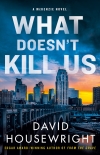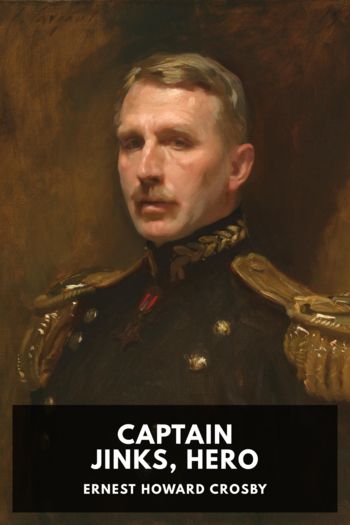What Doesn't Kill Us--A McKenzie Novel, David Housewright [best young adult book series .txt] 📗

- Author: David Housewright
Book online «What Doesn't Kill Us--A McKenzie Novel, David Housewright [best young adult book series .txt] 📗». Author David Housewright
Unfortunately, the kid working behind the counter said he was unable to serve the young woman a sausage, egg, and cheese sandwich with decaf coffee and a hash brown patty on the side because the restaurant stopped serving its breakfast menu at ten thirty A.M. sharp and it was now ten thirty-seven. The woman didn’t care. She wanted a goddamned sausage, egg, and cheese sandwich with decaf coffee and a hash brown patty on the side and she wanted it now. She told the kid to stop being “anal-retentive,” was the word she used. After all, it was only seven minutes past the deadline and she was wearing a short, sequin dress that showed off her chest, so c’mon.
The kid didn’t comment on the short, sequin dress or her chest, but did say that he was sorry; the ten thirty shut-off time could not be ignored, the instructions coming down from corporate itself. Could he interest her in a burger or a crispy chicken sandwich, instead? The woman would accept no substitutes, however. To prove it, she pulled a small handgun from her bag, waved it at the kid, and said she would have a sausage, egg, and cheese sandwich with decaf coffee and a hash brown patty on the side “by any means necessary.”
The administrative coordinator had been watching the exchange between the counter kid and the young woman from his booth with increasing amusement. He had made up his mind to intervene on the woman’s behalf; it would give him the opportunity to get to know her better, so to speak. When she pulled her gun, though, he pulled his, a Kimber Micro 9 Stainless Raptor—the man had a Permit to Carry a Pistol issued by the Ramsey County Sheriff’s Department. He testified later that he had been waiting for a moment like this for years. He shot at the woman; emptied his gun, in fact; six rounds in the mag and one in the throat. He missed her completely, although he did graze the shoulder of the kid behind the counter and blast apart a lot of the equipment, including a coffee machine that began leaking everywhere.
The woman took exception to being used for target practice and turned on the coordinator.
“What is wrong with you?” she wanted to know.
“You have a gun,” he reminded her.
She pointed it at him and squeezed the trigger.
A steady stream of water hit him right between the eyes.
She laughed.
He whacked her in the face as hard as he could with the butt of the handgun, knocking her down.
That’s when the police officer arrived.
He saw the woman writhing on the floor, blood pouring from her nose and upper lip.
He saw the kid holding his arm, blood seeping between his fingers.
He saw the smashed and leaking coffee machine behind the kid.
He saw the man waving his Kimber nine-millimeter handgun and screaming, “It’s all her fault!”
The officer drew his Taser and hit him with 50,000 volts.
By the time Bobby and Gafford had arrived, the counter kid was being treated by an EMT for what the kid clearly thought was a life-threatening wound but the EMT diagnosed as superficial.
“If it were up to me, I would have given her a sausage, egg, and cheese sandwich with decaf coffee and a hash brown patty on the side,” the kid said. “But corporate … They’re going to be so upset.”
Both the man and woman had been taken into custody and were being held in the backs of separate patrol cars. During questioning, they were both adamant that they had done nothing wrong, the man in particular. He kept insisting that he had “acted within my God-given Second Amendment rights” and that “the St. Paul Police Department would pay for its racist behavior” because the officer who tased him looked like he had Hispanic origins. As for the woman, apparently her twenty-three years on the planet had prepared her for days like this.
“Life is so unfair,” she said. “But what are you gonna do?”
Bobby knew the sergeant who was supervising the scene; he had worked with him many times. The sergeant was shaking his head sadly at the entire situation.
“What a bunch of fucktards,” he said.
“Shh,” Bobby hissed. “Not so loud.”
“Hey. What’s this I hear about McKenzie? He took a round in the back? Is he gonna be all right?”
“Last I heard.”
“I remember working with McKenzie out of the Phalen Village Storefront in the Eastern District back when—God, we were both kids. We used to call him ‘Mac’ back then. He hated that.”
“Still does.”
“Do we know who shot him?”
“Not yet.”
“Reason I bring it up—maybe you should know something. Maybe you already do.”
“Know what?”
“There’s a PI”—the sergeant quoted the air—“making inquiries about the shoot. Claims to be a friend of Mac’s.”
“Is that right?”
“What I heard.”
“Did you hear a name?”
“Something Schroeder works out of an office in Minneapolis.”
Nina Truhler moved through her club like a set of Newton balls, the desk toy that has five steel balls hanging from thin wires on a wooden or metal frame, also called a Newton’s cradle. When a ball on one end of the cradle is pulled away and then dropped, it hits the other balls, sending energy through the middle three and flinging the ball on the opposite end of the row into the air. That ball then swings back to strike the other balls again, starting the chain reaction in reverse that will eventually throw the first ball into the air, and so on and so forth, demonstrating the principle of the conservation of energy and momentum and making an obnoxious clickety-clack sound that never seems to end. At least that’s the way Jenness Crawford, Nina’s manager, explained it to me later.
“It was like Nina was afraid





Comments (0)